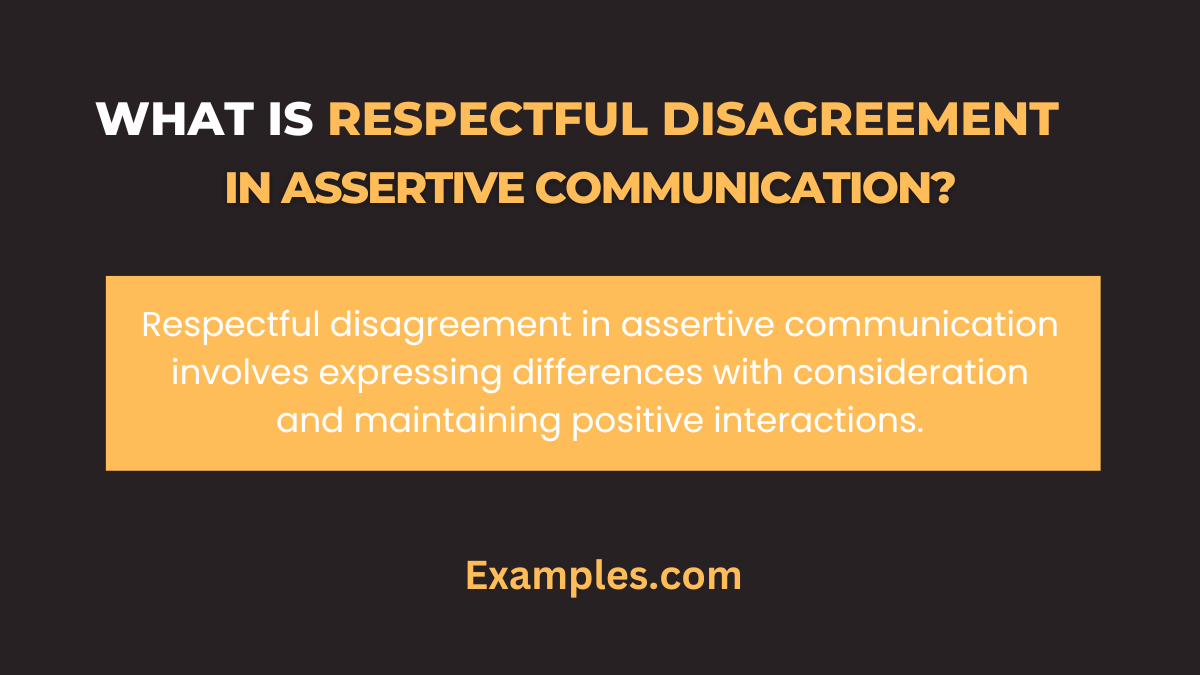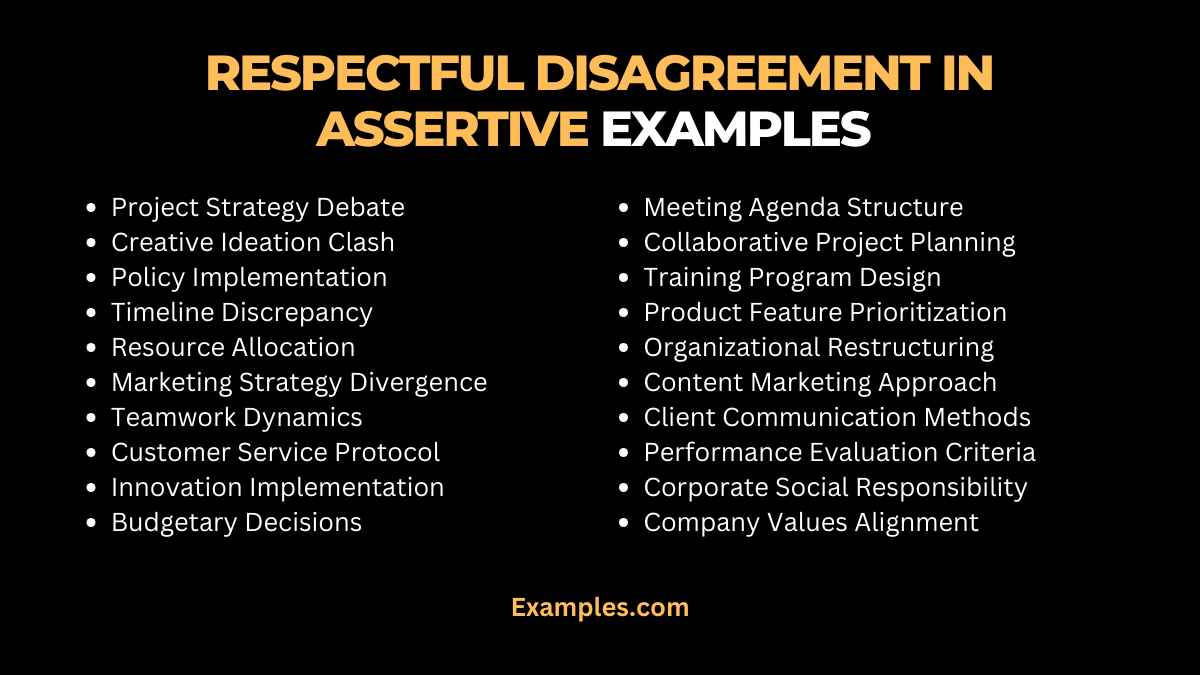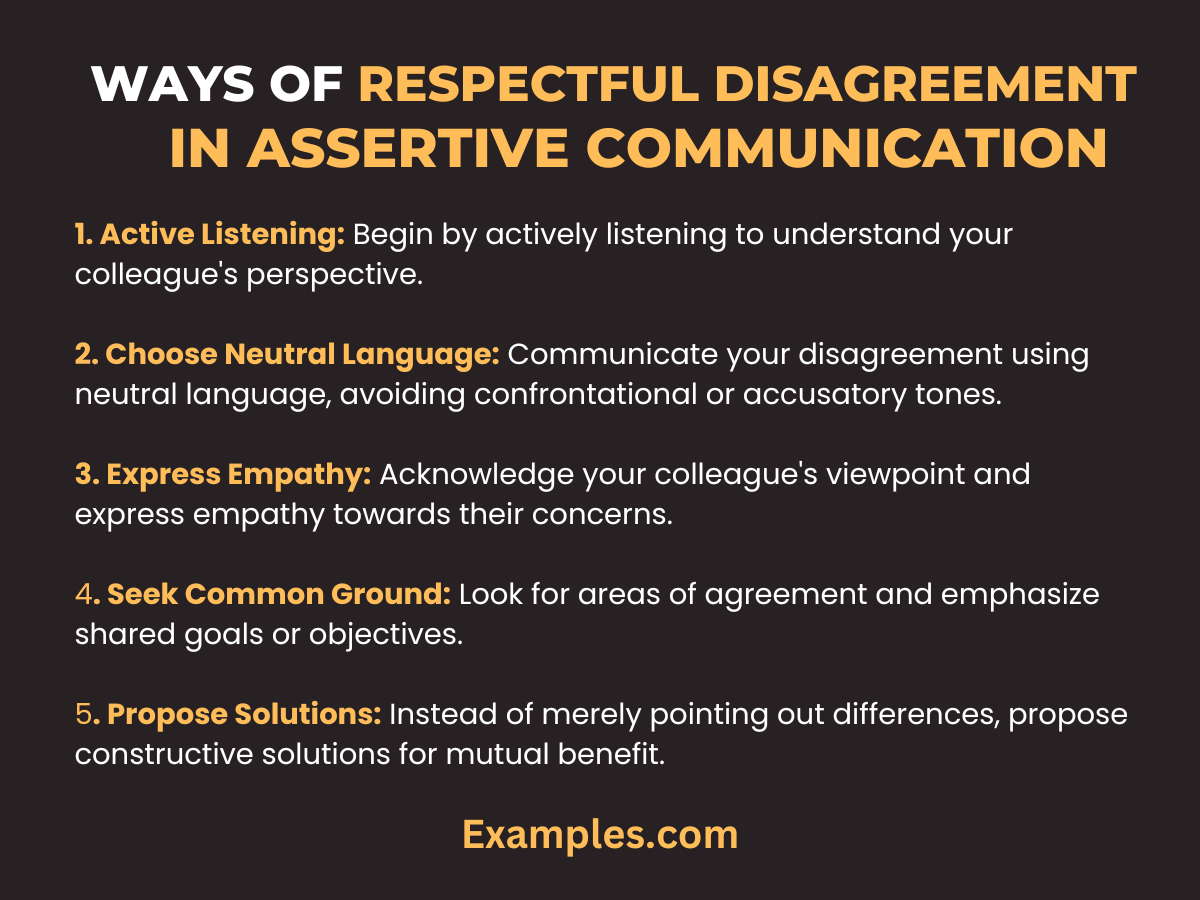19+ Respectful Disagreement In Assertive Communication Examples
In the realm of assertive communication, respectful disagreement is an essential skill. It involves expressing differing opinions tactfully, fostering constructive discussions. Understanding the nuances of this approach is crucial for effective interpersonal dynamics. This comprehensive guide delves into the definition, best examples, and practical insights for mastering respectful disagreement in assertive communication.
What is Respectful Disagreement In Assertive Communication?

Respectful disagreement in assertive communication entails expressing dissenting views while maintaining mutual respect and understanding. It revolves around navigating differences with empathy, contributing to positive discourse and relationship building. This approach ensures that conflicting opinions are expressed thoughtfully, fostering an environment where diverse perspectives coexist harmoniously.
20 Respectful Disagreement In Assertive Communication Examples

Mastering respectful disagreement in assertive communication is pivotal for fostering constructive dialogues. Explore 20 unique examples, each coupled with practical insights, to navigate differences gracefully and maintain positive interactions.
- Project Strategy Debate:In team discussions, respectfully disagree by saying, “I see your perspective, but I propose an alternative approach for greater efficiency.”
- Creative Ideation Clash:During brainstorming, express disagreement assertively, stating, “I appreciate your idea; however, I suggest a modification for better alignment with our goals.”
- Policy Implementation:In organizational decisions, disagree respectfully by affirming, “I understand the rationale, but I believe a different policy may yield better outcomes.”
- Timeline Discrepancy:Discussing project timelines, assertively disagree with, “I acknowledge the urgency, but let’s consider a more realistic timeframe for quality delivery.”
- Resource Allocation:In resource discussions, express disagreement by saying, “I respect your allocation plan, but I propose redistributing resources for optimal project success.”
- Marketing Strategy Divergence:During campaign planning, disagree by stating, “I value your approach; however, I suggest incorporating additional elements for a more comprehensive strategy.”
- Teamwork Dynamics:In team dynamics, express differing opinions by saying, “I see your point, but let’s explore a collaborative approach that considers everyone’s strengths.”
- Customer Service Protocol:Disagree on service protocols by expressing, “I acknowledge the current procedure, but I propose adjusting it to better meet customer needs.”
- Innovation Implementation:In tech discussions, respectfully disagree by stating, “I understand the innovation; however, let’s evaluate potential modifications for a smoother integration.”
- Budgetary Decisions:During financial discussions, express disagreement with, “I appreciate the proposed budget, but I suggest reallocating funds for more impactful initiatives.”
- Meeting Agenda Structure:Disagree on meeting structure by stating, “I understand the agenda; however, I propose slight adjustments for a more focused and productive discussion.”
- Collaborative Project Planning:During project planning, express differing views by saying, “I respect your ideas, but let’s refine the plan to ensure comprehensive execution.”
- Training Program Design:In educational settings, assertively disagree by stating, “I value the training program; however, let’s consider additional modules for a holistic approach.”
- Product Feature Prioritization:Express disagreement on feature priorities by stating, “I acknowledge the chosen features, but I propose reconsidering based on user feedback for optimal satisfaction.”
- Organizational Restructuring:During structural changes, respectfully disagree by expressing, “I understand the restructuring; however, let’s evaluate alternatives for minimal disruption.”
- Content Marketing Approach:In marketing discussions, express disagreement by saying, “I value the content strategy, but I suggest tweaking it for increased audience engagement.”
- Client Communication Methods:Disagree on communication methods with clients, stating, “I appreciate the current approach, but let’s explore more personalized methods for stronger client relationships.”
- Performance Evaluation Criteria:In HR discussions, express disagreement by stating, “I understand the criteria; however, let’s consider additional factors for a more comprehensive performance evaluation.”
- Corporate Social Responsibility Initiatives:Disagree on CSR initiatives by expressing, “I acknowledge the proposed initiatives, but I suggest exploring partnerships for a broader impact.”
- Company Values Alignment:Express disagreement on values by stating, “I respect our principles; however, I propose refining them to better align with our evolving organizational culture.”
Respectful Disagreement In Assertive Communication Examples in Listening
Explore how listening becomes a powerful tool in navigating disagreements with respect. This collection of examples illuminates how assertive communication, combined with attentive listening, enhances understanding and fosters collaborative solutions.
- Active Acknowledgment: Practice active listening by saying, “I hear your concerns; let’s explore solutions together.”
- Reflective Responses: Show respect by reflecting on opposing views, asserting, “I understand your perspective; let’s discuss possible compromises.”
- Empathetic Understanding: Demonstrate empathy by acknowledging emotions, saying, “I sense your frustration; let’s work towards resolution collaboratively.”
- Clarification Queries: Seek clarification respectfully, asking, “Can you elaborate on your concerns to help me understand better?”
- Open-Ended Inquiries: Encourage dialogue with open-ended questions like, “Can you share more about your thoughts? I’m interested in understanding your perspective.”
- Nonverbal Affirmations: Express agreement through cues, nodding, and maintaining eye contact while saying, “I appreciate your input; let’s find common ground.”
- Summarization Technique: Summarize the opposing view, showing comprehension, and respond, “If I understand correctly, you’re suggesting… How about we explore a middle ground?”
- Neutral Language: Communicate neutrally, stating, “I don’t fully agree, but I respect your opinion; let’s find a compromise benefiting both.”
- Validation Statements: Recognize feelings by saying, “I acknowledge your disappointment; let’s find a solution addressing your concerns.”
- Future Resolution Commitment: Express commitment, saying, “Though we disagree now, I’m dedicated to finding common ground for mutual benefit.”
What is Respectful Disagreement In Assertive Communication with Someone at Work?
Respectful disagreement at work involves expressing dissent with courtesy and professionalism. It’s about fostering open communication while maintaining mutual respect, allowing diverse perspectives to contribute to constructive discussions, ultimately leading to better decision-making within the workplace.
What are Ways of Respectful Disagreement In Assertive Communication with Someone at Work?

Navigating disagreements at work requires a delicate balance of assertiveness and respect. Follow these steps to foster a culture of respectful disagreement:
- Active Listening: Begin by actively listening to understand your colleague’s perspective.
- Choose Neutral Language: Communicate your disagreement using neutral language, avoiding confrontational or accusatory tones.
- Express Empathy: Acknowledge your colleague’s viewpoint and express empathy towards their concerns.
- Seek Common Ground: Look for areas of agreement and emphasize shared goals or objectives.
- Propose Solutions: Instead of merely pointing out differences, propose constructive solutions for mutual benefit.
- Maintain Professionalism: Throughout the discussion, uphold a professional demeanor, focusing on the issue at hand rather than personal differences.
- Encourage Open Dialogue: Foster an environment where colleagues feel comfortable expressing dissenting opinions.
- Use I Statements: Frame your disagreement using “I” statements to convey personal perspectives without sounding accusatory.
Tips for Effective Respectful Disagreement In Assertive Communications
- Active Listening: Listen attentively to understand the other’s perspective fully.
- Neutral Language: Use language that focuses on the issue, avoiding personal attacks.
- Open Dialogue: Encourage open and honest communication to express differing views.
- Seek Common Ground: Identify areas of agreement to build on common objectives.
- Professional Tone: Maintain a respectful and professional tone throughout the discussion.
Mastering the art of respectful disagreement in assertive communication is a vital skill in today’s diverse and interconnected world. It allows individuals to express differing opinions and perspectives in a manner that fosters understanding and respect, rather than conflict and division. This skill is not just important in personal interactions but is also critical in professional environments where collaboration and effective problem-solving are key. By prioritizing respect and understanding, individuals can contribute to more harmonious and productive discussions, whether in a personal, academic, or professional setting.
For those interested in further exploring the concept of respectful disagreement and its application in various contexts, there are several resources available. The University of Oxford, through its Department of Experimental Psychology, offers insights into the psychological Aspects of Disagreement and Conflict Resolution. Additionally, the United Nations, known for its efforts in promoting peace and effective communication among diverse groups, provides valuable resources and guidelines on Conflict Resolution and Assertive Communication, applicable in global and multicultural contexts. These concluding paragraphs not only summarize the essence of respectful disagreement in assertive communication but also guide the reader towards further learning from prestigious and globally recognized institutions.



